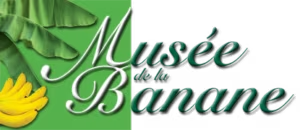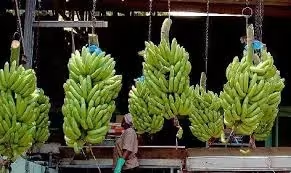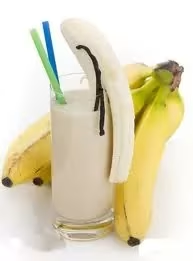💳 Payment 3 x
Easy !
Book now for a trip in 3 months, pay in 3 installments with no fees!
The Banana Museum of Martinique
The Banana Museum: between culture and cuisine
A layout conducive to discovery
Martinique has a rich fauna and flora. It is in this measure that the permanent Museum of the Banana emerged. Discovering the territory can also be done through culture.

From this point of view, you can discover during the visit of the place, various installations:
an old building with red tiles, at the entrance of the park. This one is fitted out in permanent exhibition room on panels. This place approaches the extraordinary world of the banana, through its history, its culture, its fruit, its harvest and its uses in cooking
the shed where the banana bunches are processed before being exported, and the packaging of the fruit, opposite the entrance. Indeed, let's not forget that the museum is located in a working house
the 4 hectare park, along the beautiful alley, where you can walk among the different varieties of bananas and exotic flowers, of this immense space
an ajoupa of "colored creole huts", on the left of the hangar. Here you can discover, taste and buy banana-based culinary specialties. This place is facing the brand new restaurant "la Bananeraie".
The history of the banana
Originally from Southeast Asia, the banana appeared in the Caribbean and was introduced by the Portuguese in the early 16th century. It is maintained through the decades, through practices and ancestral traditions and reserves a very large share to family jobs. It is only from the XXth century that the culture of the banana takes all its dimension. At the beginning of this era, shipments to France started timidly:
the pillar of the economy remained sugar and its derivatives (rum)
banana exports, considered as a luxury product, were rare
Indeed, until the 1950s, and despite the technical progress that facilitated the transport (refrigerated holds), this fruit was not very present.
Nevertheless, after the war, French consumers became more and more fond of this fruit. It then appeared as an alternative to the sugar culture, which after the crisis of the 60s, caused the closure of many distilleries. From then on, the banana became the first wealth of the island.
Going to the Banana Museum
The Banana Museum is in the heart of the Martinique territory. If you rent a car in Martinique, you will drive along its roads lined with banana plantations of many varieties, which grow all year round.
Bananas play an essential role in the local economy, the cultivation of this fruit covers 8300 hectares, that is to say 84% of the useful agricultural land, distributed on 1275 farms. It is mainly found in the northeast region. The banana grown in the banana plantations is exclusively intended for export. In fact, each Martiniquean owning a piece of land, he will plant a few plants for his personal consumption.
To know everything about this fruit so appreciated for its multiple virtues, go to a farm still in activity, which transformed a part of its domain, in Museum of the Banana: "the Habitation Limbé Fourniole". It is located in the greenest part of the island, in the forest that covers Mount Pelee.
Leaving Le Lamentin, on board your rental car, you will have to take the direction of Sainte-Marie, (North Atlantic), which is the largest town on the Atlantic Coast. Then, at the exit of the city, at the level of Rhums Saint-James, take the D24 in the direction of Morne des Esses.
Finally, you can park your rental car in the parking lot and find a shady spot. It is here that the Banana Museum opens its doors every day, from 9am to 4:30pm. It welcomes the visitors in a playful and educational course, around this fruit.
All about this fruit
Who has never crossed the island of Martinique, by rental car, from north to south and from east to west, to realize that it is full of banana fields and that they occupy a privileged place in Martinique. You will drive on these roads lined with banana plantations of many varieties, which grow all year round. The banana plays an essential role in the local economy, the cultivation of this fruit covers 8300 hectares or 84% of the useful agricultural land, spread over 1275 farms.
It is true that it is found mainly in the northeast region. The banana cultivated in the banana plantations is exclusively intended for export, as each Martinican owning a piece of land, will plant a few feet for his personal consumption. But to know everything about this fruit so appreciated for its multiple virtues, go, by car, in a still active exploitation which transformed a part of its domain, in museum of the banana: "the Habitation Limbé Fourniole".

It is located in the greenest part of the island, in the north, in the forest that covers Mount Pelee. Leaving Tartane, on board your rental car, take the direction of Saint-Marie, (north-east), which is the largest commune of the Atlantic Coast, at the exit of the village, at the level of Rhums Saint James, take the D 24 in the direction of Morne des Esses.
For a little less than 3 kilometers, you will pass a Hindu temple before turning right and following the arrows leading to the museum. Park your rental car in the parking lot where you can find a shady spot. It is here that the Banana Museum opens its doors every day from 9:00 am to 4:30 pm, to welcome visitors for a fun and educational tour presenting the history of this fruit.
The banana tree, its fruit, its harvest,
A real giant plant, the banana tree grows all year round and can reach up to 15 meters. After the harvest, the foot of the banana tree is cut to allow the new shoot to grow more easily. It is then necessary to wait 6 to 8 months to see appearing the flower, taken out in the heart of the plant, along a thick and curved stem.
The flower called "popotte" will open to reveal a young banana bunch which will be harvested after 90 days. The banana being a fragile fruit, the bunch will be picked by hand to avoid damaging it, by 2 men, a cutter, and a carrier.
Did you know that the banana tree needs 15 to 20 liters of water per day ....? Did you know that a banana plant bears up to 100 fruits... ?
The park
A huge tropical garden in which an incredible walk leads us to discover the multitudes of existing banana varieties, more than fifty grow and are cultivated on the Habitation, the opportunity to discover the infinite forms and colors that can take the banana bunches, such as the silver banana, the Yangambi banana, the Big Dwarf, the Fig Bird, the Frayssinette, the Makandja, the Horn, the Plantain.
By leaving the park, direction
The packaging and processing shed for banana bunches, where you can observe the process up close. The bunches arrive green, on large trailers pulled by tractors, then they are hung on hooks to be brought in front of a worker who will carefully detach each peg before throwing it in a large tub of water to remove all traces of agricultural product.
Once washed, the bananas are sorted and packed in boxes and stored in refrigerated containers, ready to be shipped to FDF, to the port, to be exported on boats refrigerated at 13° (the cold blocks the ripening process of the fruit) which reach the mainland in 10 days. The green bananas are transported on arrival to the ripening plants.
The ripening process consists of providing heat in a process ranging from 8 to 10 days, depending on the characteristics of the origins of the bananas received and the expectations of customers in terms of stage of ripeness.
To be sent to the distributor, the banana will go through another temperature reduction stage (14°) and will wait until it reaches the consumer to be fully ripe. Metropolitans prefer the banana to be yellow and smooth, while the West Indians prefer it to be tiger, when its skin is yellow and spotted and its flavor is at its best. Before reaching the parking lot, where your rental car is waiting for you, a stop at the bar set up in the village of the Creole huts is a must, where you can taste drinks made from b....... and why not let yourself be tempted by this new restaurant inaugurated only a few days ago, the day of the banana festival, which is an integral part of the Habitation, we rename it "la Bananeraie" which is singular, because it positions its menus on the rediscovery of traditional Creole cuisine through the valorization of the banana, from the starter to the dessert.


Sign up for our newsletter
And receive our promo codes and exclusive car rental offers in Martinique, delivered straight to your inbox.
Agencies & Pro


Tripadvisor

Qualité Tourisme

Travel award

Kayak
@Europcar Martinique
